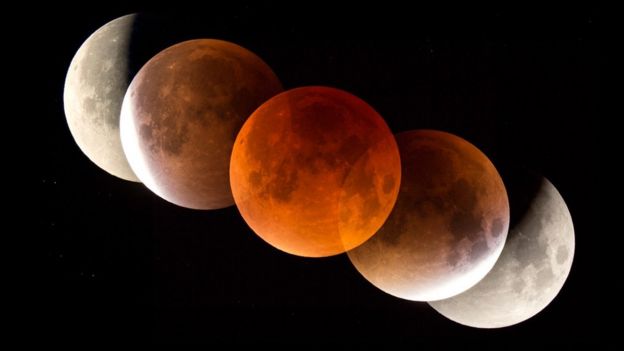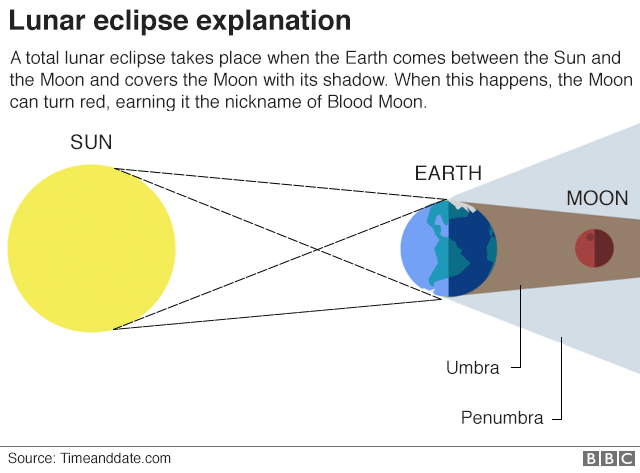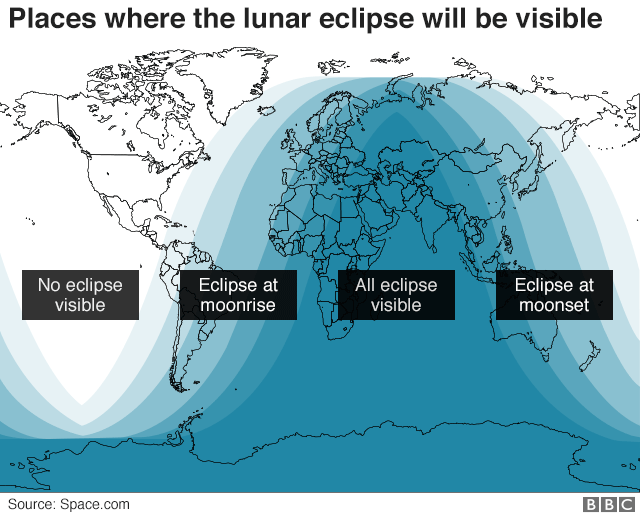Skywatchers will be treated to the longest "blood moon" eclipse of the 21st Century on Friday.
As it rises, during this total eclipse, Earth's natural satellite will turn a striking shade of red or ruddy brown.
The "totality" period, when light from the Moon is totally obscured, will last for one hour, 43 minutes.
At least part of the eclipse is visible from Europe, the Middle East, Africa, Australia, most of Asia and South America.
In the UK, rain clouds permitting, the Moon will appear entirely red - fully eclipsed by Earth - from when it rises at 21:00 to 22:15 BST.
On the same night and over the coming days, Mars will be at its closest point to Earth since 2003 - visible as a "bright red star" where skies are clear.
Why will the eclipse last so long?
The Moon will pass right through the centre of the Earth's shadow, at the shadow's widest point.
 SPL
SPL
"This is actually almost as long as a lunar eclipse could be," Prof Tim O'Brien, an astrophysicist at University of Manchester, explained.
It coincides not only with Mars's close approach, but with what he described as a "procession of planets" - a line-up of our celestial neighbours that will give skywatchers a particularly good view of Venus, Jupiter, Saturn and Mars.
Eclipse terms
Umbra: The darker, central part of the Earth's shadow
Penumbra: The lighter, outer part of the shadow cast by our planet

Because the Moon is far away from Earth relatively speaking - its orbit is an ellipse, so it moves closer and further and looks larger and smaller from Earth.
"Mars will look like this beautiful bright red star just below the Moon," said Prof O'Brien.
"Every couple of years or so, the Earth overtakes Mars on the inside as it orbits the Sun, so Mars is closest to us.
"And because of the elliptical shape of the orbit, it's even closer than normal; it really is a great time to spot Mars."
Where will the eclipse be visible?
Where skies are clear of cloud, the spectacle will be visible almost everywhere around the world, with the exception of North America. The eclipse will already have started by the time the Moon rises over the UK and Western Europe.

Prof O'Brien explained that people in the UK would "need to have a clear south-eastern horizon as the Moon comes up" in order to see it.
The best views - weather permitting - could be across Eastern Europe, Central and East Africa and South East Asia, from where the entire eclipse will be visible.
 SCIENCE PHOTO LIBRARY
SCIENCE PHOTO LIBRARY
So, from the UK and Europe, the south-east will be the place to look for the rising, eclipsing Moon with bright red Mars below. But for views of elsewhere in the Solar System, Jupiter will be in the southern sky and Venus in the west.
Dr Emily Brunsden, director of the University of York's Astrocampus, added that this eclipse was a "micro blood moon".
"This is a total eclipse at a time in its orbit when it is close to being the farthest from Earth, or at apogee," she said.
"Hence the Moon is fractionally smaller than usual."
Stages of a total lunar eclipse
- Penumbral eclipse begins: This starts when the outer (and lighter) part of the Earth's shadow begins moving across the Moon
- Partial eclipse begins: This stage takes hold when the darker, inner part of the Earth's shadow (umbra) begins covering the Moon
- Total eclipse begins: Also called totality, this occurs when the umbra completely covers the Moon, turning it a reddish brown colour
- Maximum eclipse: The mid-point of totality
- Total eclipse ends: The umbra starts moving away from the Moon's face after totality
- Partial eclipse ends: Earth's umbra completely leaves the surface of the Moon
- Penumbral eclipse ends: The outer part of the shadow (penumbra) completely moves away from the Moon
Source: timeanddate.com
